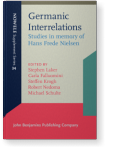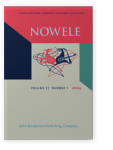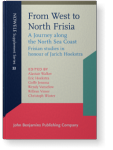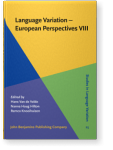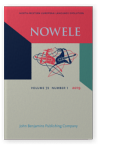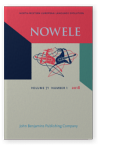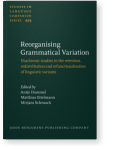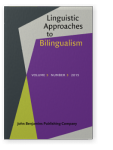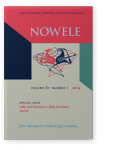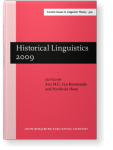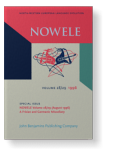Arjen P. Versloot
List of John Benjamins publications for which Arjen P. Versloot plays a role.
Book series
2024 The Old English gerund in ‑ enne or ‑ anne NOWELE 77:1, pp. 14–22 | Article
This article discusses the historical form of the gerund in Old English, attested both as ‑enne and ‑anne. The former is commonly considered to be the historical form, while the latter is thought to have resulted from analogical levelling on the basis of the infinitive that ended in ‑an. The… read more
2022 Die Entwicklung von protogermanischem * ai im Niederdeutschen: Ein Erklärungsversuch für die Spaltung des altsächsischen ē 2 From West to North Frisia: A Journey along the North Sea Coast, Walker, Alastair, Eric Hoekstra, Goffe Jensma, Wendy Vanselow, Willem Visser and Christoph Winter (eds.), pp. 395–408 | Chapter
The twofold development in Old Frisian of Proto-Germanic *ai into ā and ē contrasts with the nearly uniform rendering as 〈e〉 in Old Saxon. It has, however, been pointed out that this Old Saxon ē
2, spelled 〈e〉, shows a phonemic split in the modern Low German dialects, whose origin may go… read more
2021 Chapter 1. The volatile linguistic shape of ‘Town Frisian’/‘Town Hollandic’ Language Variation – European Perspectives VIII: Selected papers from the Tenth International Conference on Language Variation in Europe (ICLaVE 10), Leeuwarden, June 2019, Van de Velde, Hans, Nanna Haug Hilton and Remco Knooihuizen (eds.), pp. 11–34 | Chapter
Speech communities are communication communities and reflect current or historical ties within societies. Language contact is thus an expression of cultural contact. Often, when these contacts took place in the past, little is known about the sociological context, and a linguistic analysis is one… read more
2019 Reduction of unstressed vowels in Proto-Frisian and the Germanic ‘Auslautgesetze’ NOWELE 72:1, pp. 78–98 | Article
The quantitative reduction and loss of Proto-Germanic vowels during the transition from some form of Common North West Germanic to the attested ‘Old’ languages, such as Old English and Old Frisian, is a complicated process, interfering with morphological restructuring processes. Various… read more
2018 Sprachverlust und Halbsprecher einer sterbenden Sprache: Die Infinitivendungen in der friesischen Sprache des Harlingerlandes NOWELE 71:1, pp. 99–118 | Article
Dying languages are often characterised by attrition of structural features and large scale borrowing from competing dominant languages. However, these characteristics are difficult to interpret when the variety is only scarcely attested (Trümmersprache) and documented by non-native speakers,… read more
2018 Plural inflection in North Sea Germanic languages: A multivariate analysis of morphological variation Reorganising Grammatical Variation: Diachronic studies in the retention, redistribution and refunctionalisation of linguistic variants, Dammel, Antje, Matthias Eitelmann and Mirjam Schmuck (eds.), pp. 17–56 | Chapter
The present study explores the variation in the plural inflection of eight varieties of Frisian and English, focusing on irregular plural formations. The aim of the study is to identify and assess the significance of the factors which contributed to the preservation and emergence of irregular… read more
2015
In standard Dutch, the plural suffix -en is homographic and homophonic with the linking suffix -en (boek+en “books”, boek+en+kast “bookcase”), both being pronounced as schwa. In Frisian, there is neither homography nor homophony (boek+en “books”, pronounced with syllabic nasal; boek+e+kast… read more
2014 Methodological reflections on the emergence of Old Frisian Unity and Diversity in West Germanic, III, Nielsen, Hans Frede † and Patrick V. Stiles (eds.), pp. 23–49 | Article
The question addressed in this article is whether it is possible to identify the time of the emergence of Frisian from the rest of West Germanic. Some of the criteria used in determining the chronology of Frisian language history are evaluated in terms of their temporal and spatial aspects.… read more
2012 Changes in the use of the Frisian quantifiers ea/oait “ever” between 1250 and 1800 Historical Linguistics 2009: Selected papers from the 19th International Conference on Historical Linguistics, Nijmegen, 10-14 August 2009, Kemenade, Ans M.C. van and Nynke de Haas (eds.), pp. 171–190 | Article
This article presents an overview of the changes that took place in the syntactic use of the quantifiers ea and oait “ever” between 1250 and 1800 on the basis of the Frisian Language Corpus. Occurrences of Frisian ea and oait “ever” were classified and counted depending on the type of syntactic… read more
1996 Konsonantengeminaten in der Sprache der Wangerooger: Eine Einmaligkeit Unter den Westgermanischen Sprachen NOWELE Volume 28/29 (August 1996): A Frisian and Germanic Miscellany, Petersen, Adeline and Hans Frede Nielsen † (eds.), pp. 241–250 | Article
